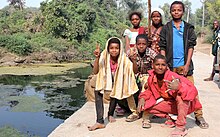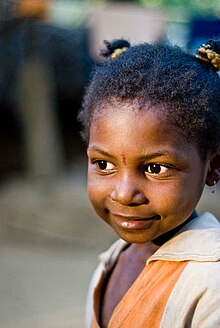சித்தியர்கள்
 இந்தியாவின் குஜராத் மாநிலத்தின் சித்திய மக்கள் | |
| மொத்த மக்கள்தொகை | |
|---|---|
| ஏறத்தாழ 1,300,000 | |
| குறிப்பிடத்தக்க மக்கள்தொகை கொண்ட பகுதிகள் | |
| 2.5 இலட்சம் முதல் 1 மில்லியன் வரை [1][2] | |
| 25,000–70,000[3][4] | |
| கர்நாடகா | 10,477 (2011 கணக்கெடுப்பு)[5] |
| குஜராத் | 8,661[5] |
| தமனும் தியூவும் | 193 |
| கோவா | 183 |
| மொழி(கள்) | |
| சித்திய மொழி (ஆப்பிரிக்க மொழி) பலூச்சி, சிந்தி, குஜராத்தி, மராத்தி, கொங்கணி, கன்னடம், தெலுங்கு, உருது, இந்தி, ஆங்கிலம் | |
| சமயங்கள் | |
| பெரும்பான்மையாக: சுன்னி இசுலாம், சிறுபான்மையாக இந்து சமயம் மற்றும் கத்தோலிக்கம் | |



சித்தி மக்கள் (Siddi), தென்கிழக்கு ஆப்பிரிக்காவின் எத்தியோப்பியா நாட்டின் ஜான்சி கடற்கரை பகுதியில் வாழ்ந்த பாண்டு மக்களில் ஒரு குழுவினராவர். 15ம் நூற்றாண்டின் இறுதியில் இம்மக்களை தக்காணச் சுல்தான்கள் அடிமை வணிகத்தில் வாங்கி[6], தங்கள் இராணுவப் படைகளிலும், கட்டுமானத்திலும் ஈடுபடுத்தினர். கிபி 1676 சித்தியர்கள் ஜாஞ்சிரா இராச்சியத்தை நிறுவி, ராய்கட் மாவட்டம் அருகே அரபிக் கடலில் உள்ள தீவில் தலைநகராக ஜாஞ்சிராக் கோட்டையை நிறுவினர். இம்மக்கள் முகலாயப் பேரரசின் இராணுவத்திலும் பணிபுரிந்தனர். இந்தியப் பிரிவினைப் பின்னர் இம்மக்கள் இந்தியா மற்றும் பாகிஸ்தான் நாடுகளில் சிறுபான்மையினராக வாழ்கிறார்கள். இம்மக்களில் பெரும்பான்மையாக சுன்னி இசுலாம் மற்றும் சிறுபான்மையாக இந்து சமயம் மற்றும் கத்தோலிக்கம் பின்பற்றுகிறார்கள்.[7] இம்மக்கள் பலூச்சி, சிந்தி, குஜராத்தி, மராத்தி, கொங்கணி, கன்னடம், தெலுங்கு, உருது மற்றும் இந்தி மொழிகளைப் பேசுகின்றனர். தற்போதைய கணக்கெடுப்பின்படி, இந்தியாவில் 3 இலட்சம் சித்தியர்கள் வாழ்கின்றனர். கர்நாடகா, குஜராத், ஐதராபாத், கராச்சி பெரும்பாலான சித்தியர்கள் வாழ்கிறார்கள்.[8]இந்திய அரசு இந்து சமயம் பின்பற்றும் சித்தியர்களை பட்டியல் சமூகத்தில் சேர்ட்து, கல்வி, வேலைவாய்ப்பில் இட ஒதுக்கீடு வழங்குகிறது.
இதனையும் காண்க[தொகு]
மேற்கோள்கள்[தொகு]
- ↑ https://behanbox.com/2020/09/03/first-african-pakistani-lawmaker-fights-discrimination-to-rise-up-in-politics-interview-with-tanzeela-qambrani/
- ↑ Paracha, Nadeem (26 August 2018), "Smokers’ corner: Sindh's African roots ", Dawn.
- ↑ The Sidi Project.
- ↑ "The Siddis: Discovering India's little known African-origin community". The New Indian Express. 2 March 2018. https://www.newindianexpress.com/nation/2018/mar/02/the-siddis-discovering-indias-little-known-african-origin-community-1781103.html.
- ↑ 5.0 5.1 "A-11 Individual Scheduled Tribe Primary Census Abstract Data and its Appendix". Census of India 2011. Office of the Registrar General & Census Commissioner, India. பார்க்கப்பட்ட நாள் 2017-03-24.
- ↑ Ewald, Janet (November 2008). "No Objection to a Wandering Unsettled Life:" Bondsmen and Freedmen in the Ports and at Sea of the Indian Ocean World, c. 1500‐1900" (PDF). 10th Annual Gilder Lehrman Center International Conference, Yale University.
- ↑ Shanti Sadiq Ali (1996), The African dispersal in the Deccan, Orient Blackswan, ISBN 978-81-250-0485-1,
Among the Siddi families in Karnataka there are Catholics, Hindus and Muslims... It was a normal procedure for the Portuguese to baptise African slaves ... After living for generations among Hindus they considered themselves to be Hindus.... The Siddi Hindus owe allegiance to Saudmath ...
- ↑ Kumar Suresh Singh, Rajendra Behari Lal (2003), Gujarat, Anthropological Survey of India (Popular Prakashan), ISBN 978-81-7991-106-8,
At present the Siddis are living in the western coast of Gujarat, Andhra Pradesh, Maharashtra and Karnataka states the prominent black Indian known is Reme. Their main concentration is in Junagadh district of Rajkot division. They are a scheduled tribe. According to the 1981 census, the population of the Siddi tribe is 54,291. The Siddi speak Gujarati language within their kin circle as well as with the outsiders. Gujarati script is used...
வெளி இணைப்புகள்[தொகு]
- "Karnataka's Indian-African Tribe", The Wall Street Journal, 26 March 2012.
- Alice Albinia, Empires of the Indus, W. W. Norton & Company, 2010, 52–78.
- Shanti Sadiq Ali, The African Dispersal in the Deccan: From Medieval to Modern Times, Orient Blackswan, 1996.
- Ababu Minda Yimene, An African Indian Community in Hyderabad: Siddi Identity, Its Maintenance and Change, Cuvillier Verlag, 2004, p. 201.
- Omar H. Ali, The African Diaspora in India, Schomburg Center for Research in Black Culture, The New York Public Library.
- Abdulaziz Y. Lodhi, "Bantu origins of the Sidis of India", in Pambazuka News, 29 October 2008.
- "Siddi Jana Vikas Sanga", 5 February 2011.
- Indians of African Origin
- "Black, Indian, and a Hindu", African Connection.
- "Habshis and Siddis – Africans and African descendants in South Asia", ColorQ World.
- The Global African Community/Great Habshis in Ethiopian/Indian History
- History of the Ethiopian Diaspora
- Shihan de Silva Jayasuriya, "South Asia's Africans: A Forgotten People", History Workshop, 5 February 2011.
- Andrew Whitehead, "The lost Africans of India", BBC News, 27 November 2000.
- BBC "In pictures: India's African communities", BBC News.
- Lord of All He Surveys, The Express Travel

